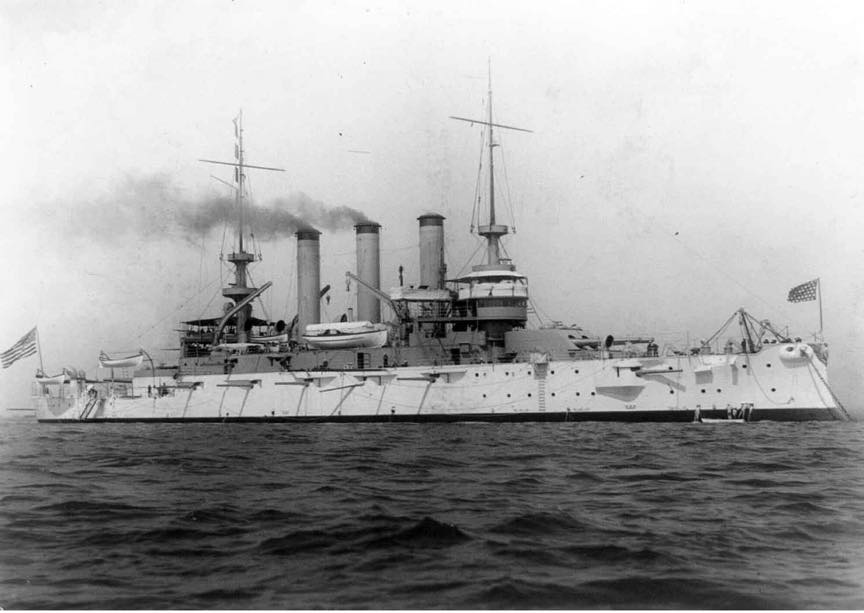USS Missouri BB-11

Missouri III (BB-11: dp. 13,500, l. 393'11", b. 72'2", dr. 25'8", s. 18.15 k.; cpl. 592; a. 4 12", 16 6", 6 3", 8 3-pdrs.; cl. Maine)
The third Missouri was laid down by Newport News Shipbuilding & Dry Dock Co., Newport News, Va., on 7 February 1900; launched on 28 December 1901, sponsored by Mrs. Edson Gallaudet, daughter of Senator Francis Marion Cockrell of Missouri, and commissioned on 1 December 1903, with Capt. William S. Cowles in command.
Assigned to the North Atlantic Fleet, Missouri left Norfolk on 4 February 1904 for trials off the Virginia Capes and fleet operations in the Caribbean. On 13 April, during target practice, a flare-back from the port gun in her after turret ignited a powder charge and set off two others. No explosion occurred, but the rapid burning of the powder suffocated 36 of the crew. Prompt action prevented the loss of the warship, and three of her crew were awarded Medals of Honor for extraordinary heroism. After repairs at Newport News, Missouri sailed on 9 June for duty in the Mediterranean, from which she returned to New York on 17 December.
Fleet operations along the East Coast and in the Caribbean during the next years were highlighted by her relief to earthquake victims at Kingston, Jamaica, from 17 to 19 January 1907. In April, she took part in the Jamestown Exposition.
With the "Great White Fleet," Missouri sailed from Hampton Roads on 16 December 1907, passing in review before President Theodore Roosevelt at the beginning of a world cruise, which was to show the world that American naval might could penetrate any waters. Calling at ports in the Caribbean and along the East Coast of South America, the fleet rounded Cape Horn to call in Peru and Mexico before arriving in San Francisco in May 1908 for a gala visit. In July, the fleet turned west for Honolulu, New Zealand, and Australia, arriving in Manila on 2 October. The most tumultuous welcome yet came in Yokohama, and with a call at Amoy, China, the fleet began the passage home via Ceylon, Suez, and ports in the Eastern Mediterranean. Departing Gibraltar on 6 February 1909, the fleet was again reviewed by President Roosevelt upon its triumphant return to Hampton Roads on 22 February. An important diplomatic mission had been carried out with great success.
Placed in reserve at Boston on 1 May 1910, Missouri recommissioned on 1 June 1911 and resumed East Coast and Caribbean operations with the Atlantic Fleet. In June 1912, she carried marines from New York to Cuba, where they protected American interests during a rebellion. The next month, the battleship carried midshipmen for training, then decommissioned at Philadelphia on 9 September 1912.
Missouri recommissioned on 16 March 1914 for that summer's Naval Academy Practice Squadron's cruise to Italian and English ports. She returned to ordinary at Philadelphia on 2 December 1914 but recommissioned on 15 April 1915 to train midshipmen in the Caribbean and on a cruise through the Panama Canal to California ports. She returned to the Reserve Fleet at Philadelphia on 18 October 1915, recommissioned on 2 May 1916, and again conducted training along the East Coast and in the Caribbean until placed in ordinary for the winter at Philadelphia.
Upon the entry of the United States into World War I, Missouri recommissioned on 23 April 1917, joined the Atlantic Fleet at Yorktown, Va., and operated as a training ship in the Chesapeake Bay area. On 26 August 1917, Rear Adm. Hugh Rodman broke his flag in Missouri as Commander, Division 2, Atlantic Fleet, and the warship continued to train thousands of recruits in engineering and gunnery for foreign service on warships and as armed guards for merchant vessels.
Following the Armistice, the battleship was attached to the Cruiser and Transport Force, departing Norfolk on 18 February 1919 on the first of four voyages to Brest to return 3,278 U.S. troops to East Coast ports. Missouri decommissioned at the Philadelphia Navy Yard on 8 September 1919. She was sold to J.A. Hitner and W.F. Cutler of Philadelphia on 26 January 1922 and scrapped in accordance with the treaty limiting naval armaments.
 >
>